
| Péter Mátyás | Boys Behind Bars |

|
Árpád Sopsits: Abandoned
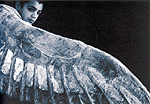 191 Kbyte |
The heroes of Abandoned call out to us. They gaze at us accusingly and hungry for love, warning of the drastic snatching away of childhood. The innocent children are barred and excluded from the world of unloving adults and, growing up without families, they gather strength for survival from their loneliness and dreams. The creations of Dickens, Oliver Twist and David Copperfield wave to us from the distance. Árpád Sospits' new film is set in Hungary in October 1960. The nine-year-old Áron Soproni is put in a boys' home by his father. The parents have divorced, the father is poor and would like to remarry and doesn't want to or is unable to look after the child. The mother being ill - she might go blind - is unable to raise her son. Arriving at the home, Áron seeks protection in the lap of the only female member of staff, Marika. The adaptation is a painful process: he is interrogated and beaten up in his blanket by the boys. In the straight suit of socialist reform education the teachers keep the boys under pressure, reverting frequently to physical punishment. Within a few weeks Áron and six of his companions make friends and form a gang. They escape at Christmas and set off - towards the lost home. The metaphorical quality of Abandoned is open to two different readings. One is the contrasting of the world of children and adults, while the other can be interpreted along the lines of a similarity between external society and life within the institution. At the beginning of the film, in the dream sequence of flying a kite, the father, the mother and Áron pass down the kite from hand to hand. All at once the boy rises and begins to fly with his angel's wings. However, the father tugs at the string tied to his waist and the boy falls back onto the ground. This effective expression for the loss of innocence and happiness is replaced by grim reality. Áron protesting against his father's decision and trying to escape, is taken to the home his wrists tied with straps. In the following scene we watch through the glass window as the father and the headmaster talk, while Áron turning his back on them, gazes into darkness. The two grown-ups and the child are divided by the window frame. The separation and alienation between the two worlds has now become final. The abandoned boy fleeing into his memories is first interrogated and then initiated with a heavy beating by his new companions. From childish rhymes, glances, joint adventures and jokes the company is forged into a community. They need one another, the other's touch and love. Attila, whose father is a political prisoner in the early Kádár era, becomes Áron's best friend. One night Áron strokes Attila and they give each other a kiss. On another Áron gets into Attila's bed and the two boys cuddle up. Some people interpret this as a homosexual gesture, but I think they're mistaken. Adolescent desire, like Áron and Attila's awakening masculinity, focuses on Marika upon whom they spy while she's taking a shower. But the warmth of a family, the love and embrace of a mother cannot be substituted by the sight of a naked bathing woman. The two boys not only need the community of the gang offering a sense of security, they need a deeper, physical-spiritual friendship as well, where love also manifests itself in touch and physical proximity. Thus the finely composed, more delicate scenes raise Áron and Attila's interdependence to a higher, more ethereal level. The steps of the children enclosed behind the bars of fear are guarded by three teachers. The grown-ups fight a merciless battle for the fragile souls of the children, trying to break their integrity, mainly through punishment and rarely through reward. Their faith is lost, their dreams shattered and they are forced into the ruthless rules of society. The director is spineless, a typical compromiser, who fears denunciation every moment and carries on a secret and joyless sexual relationship with Marika. Pál Mácsai shines in the role of the mean Mr Csapó. Starting his career twenty years ago, around the time of the Second World War, he is now disillusioned and cynical. He despises everyone, most of all himself - as borne out by his sarcastic birthday remark. He boasts of knowing the children's feelings and wishes, and sits around alone in the evenings under his lamp censoring the boys' letters. He's not fussy in his methods, he re-educates the children with intimidation, threats and beating. "This is a harsh world," he repeats searching for pedagogical justification for his actions. Csapó isn't a sadist, he doesn't indulge in physical chastisement. He demands a military discipline from everyone. But being spiritually deformed, he's dangerous in his power. He's an ill, bitter man, a latent paedophile. On one occasion he makes a member of the gang, Hajós, undress while he looks on, his mouth practically watering, and finally forces him to inform on his friends. As a contrast to him Mr Nyitrai represents humanness and good-will. Once an astronomer, he was imprisoned because of the 1956 revolution and now, separated from his family, he is offered a chance to integrate in the periphery of society. At night he plays the cello and tells Áron about the stars. During public punishments he casts his eyes down or marches out of the room - he's not tough enough for this world. Not belonging to anyone, his lonely fight makes him weak and vulnerable. He is the only representative of science, art and political correctness. His figure of a good teacher however, over-crowded with symbols, comes over as slightly studied. Abandoned avoids deliberate talk of politics. Nevertheless every consequence of the suppressed revolution of 1956 is inherent in everyone. We know that political consolidation and the resuming of work could only be ensured with the secret police's means of intimidation and the bayonets of the Soviet army. Thousands were executed and the number of the imprisoned and interned comes to tens of thousands. The Kádár regime was the paradise for informers and the death cell of physically tormented and spiritually maimed people. The difference between the internal and external world became blurred; the society of free people gave off the same smell of prison as the condemned. In Péter Gothár's film Time Stands Still, Lajos Öze, released with amnesty is asked what it was like inside. Öze asks back: "Why, what was it like outside?" The closed microcosm of the institution is modelled on the functioning of society. The identity of the inner and outer prison world is best illustrated by the hair-raising dialogue in which the senior boy, Seprödi, interrogates Áron. Seprödi: "Why were you brought here?" Áron: "I don't know. What do you want?" Seprödi: "Nothing, we just want to know why you're here." Áron: "I didn't do anything!" Seprödi: "Didn't you? You're lying! They don't bring anyone here bound in straps. Sooner or later you'll tell us everything anyway." Fear creeps under your skin in Abandoned. A merciless struggle for existence goes on, behind which the writer Géza Ottlik's world of betrayal and humiliation surfaces. The force of camaraderie characteristic of his School on the Frontier blazes in the bitter cold, the boys are risking their lives when they flee. The landscape and the material environment both in Ottlik's novel and in Sopsits's film receive particular emphasis. The seasons exist as entities that determine events and cannot be wiped out of our souls. The institute is a manor that has seen better days, with its crumbling walls, barred windows and yellowish peeling plaster. The greens still present at first gradually fade and are replaced by cheerless mud-black, sad browns and coldly glowing white. The initial autumn light is supplanted by the greyness of winter days and the chilling sooty-black of the nights. Creaking iron doors, empty rooms resounding from the echo of loneliness, bare woods and frozen rivers - the prevalent space of the narrative forms itself from the hopeless and bleak outer world. The direction unravels the rich symbolism of the round-about in the yard with sensitivity. This is the site of the children's amusement and the counsels of the gang. On the other hand it is also the terrain of imagination and conscience: Áron is haunted in his nightmares by the dead Attila spinning on the round-about. At the same time it has links with longing and freedom. It is sitting here that Áron finds his stars in the sky with the help of Nyitrai's map, and the plan of escape originates. Abandoned cleverly combines the methods of modern and classic film-making. The shots filmed at eye level are varied with a subjective use of camera. When Áron first enters the gates of the home, the camera drops from shoulder height to the boy's level, then showing his face it finally rests on the building from this lower angle. As a consequence of the portrayal from the child's point of view, the run-down manor looks larger, almost fort-like. In another scene Áron has to carry a crate filled with coal across the yard. Hardly being able even to lift it, he drags his load for long minutes. During this the camera tracks to and fro, going up-close first to the child, and then the crate. We are within body range: we can almost feel the snow's piercing cold and the boy's hot perspiration. The tracking on and off him has particular significance in creating the internal dynamics and emotional effect of the pictures. When familiarising himself with the home Áron walks down long corridors and empty rooms, his loneliness increasing, while the camera follows him all the time into the spacious interiors. With one exception Sopsits always manages to choose the appropriate form of expression. Unfortunately the already mentioned scene of kite flying lacks originality. Fellini's masterpiece, 8 1/2 begins in a similar way. There the principal character, escaping from the suffocating constriction of a car, rises in the air and flies with outstretched arms until the others jerk him back to the ground by the strings fastened to his body. The opening scene of Abandoned is wound up too much in Fellini's style: the pictures are familiar and intrusive. The harshness of the choice of subject, the depiction of the fate of the outcasts, the amateur actors and its concise language lends the film a remarkable naturalness. Behind the bitterness and despair, a desire to live and the desperate longing for pleasure and human sympathy is always lurking. These motifs relate Abandoned to De Sica's film Shoeshine of 1946. The non-professional child actors are wonderful; the interpretation both of Tamás Mészáros (Áron) and Péter Müller (Seprödi) is excellent. The latter's sunken eyes and precocious face is a good counterpoint to the clear features and angelic look of Áron. Sopsits' film based upon personal experience examines whether or not within a society condemned to muteness and compromise individuality has a chance, or whether everything is fated to fail. Áron is first guided by the stars introduced to him by Nyitrai. The feeling of confinement and belonging somewhere culminates in the Christmas Eve prayers, that - regardless of faith - all the members of the gang serving their punishment join in. The following morning they escape and wander through a desolate lunar landscape. They are crossing the frozen river Tisza, when the ice breaks and Attila is carried away by the current. The director presents another beautiful example of the film's metaphorical quality. In one of Áron's earlier dreams his adored mother feeling around blindly, knocks a vase down on the floor. The water spills and the family and happiness fades for ever. At the end of the film the surface of the river is covered in ice. The crack, the crevasse becomes the metaphor for the secret working of death. Though unsaid, it has always been present among them, but now it is revealed first in Attila's accident, and later in Nyitrai's suicide. The gesture of an ivory tower or of escaping into stars and music can't be kept up for long. Death on the other hand is not surrounded by noble pathos, nor is there any reconciliation. Mean Mr Csató holds Áron responsible for the accident and declares him a murderer. Treated like a criminal, his head is shorn and he's taken to a more severe institution. We cannot forget Áron's desperate and hopeless face. The last pictures are reminiscent of Truffaut's The 400 Blows. In both cases it is the same enigmatic look, the questioning and the accusing, the child's longing and the grown-up's disillusion. There is no absolution.
|  128 Kbyte
| 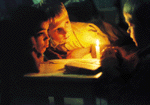 108 Kbyte
| 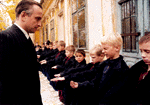 170 Kbyte
| 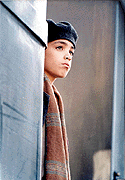 132 Kbyte
| 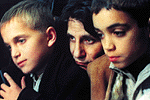 132 Kbyte |